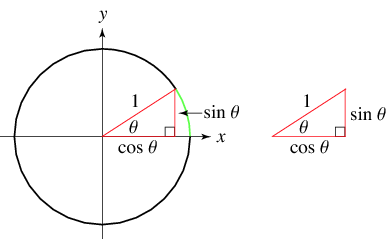The study of angles and the angular relationships of planar and three-dimensional figures is known as trigonometry. The trigonometric functions (also called the circular functions) comprising trigonometry are the cosecant ![]() , cosine
, cosine ![]() , cotangent
, cotangent ![]() , secant
, secant ![]() , sine
, sine ![]() , and tangent
, and tangent ![]() . The inverses of these functions are denoted
. The inverses of these functions are denoted ![]() ,
, ![]() ,
, ![]() ,
, ![]() ,
, ![]() , and
, and ![]() . Note that the
. Note that the ![]() notation here means inverse function, not
notation here means inverse function, not ![]() to the
to the ![]() power.
power.

The trigonometric functions are most simply defined using the unit circle. Let ![]() be an angle measured counterclockwise from the x-axis along an arc of the circle. Then
be an angle measured counterclockwise from the x-axis along an arc of the circle. Then ![]() is the horizontal coordinate of the arc endpoint, and
is the horizontal coordinate of the arc endpoint, and ![]() is the vertical component. The ratio
is the vertical component. The ratio ![]() is defined as
is defined as ![]() . As a result of this definition, the trigonometric functions are periodic with period
. As a result of this definition, the trigonometric functions are periodic with period ![]() , so
, so
| (1) |
where ![]() is an integer and func is a trigonometric function.
is an integer and func is a trigonometric function.

A right triangle has three sides, which can be uniquely identified as the hypotenuse, adjacent to a given angle ![]() , or opposite
, or opposite ![]() . A helpful mnemonic for remembering the definitions of the trigonometric functions is then given by "oh, ah, o-a," "Soh, Cah, Toa," or "SOHCAHTOA", i.e., sine equals opposite over hypotenuse, cosine equals adjacent over hypotenuse, and tangent equals opposite over adjacent,
. A helpful mnemonic for remembering the definitions of the trigonometric functions is then given by "oh, ah, o-a," "Soh, Cah, Toa," or "SOHCAHTOA", i.e., sine equals opposite over hypotenuse, cosine equals adjacent over hypotenuse, and tangent equals opposite over adjacent,
| (2) | |||
| (3) | |||
| (4) |
Another mnemonic probably more common in Great Britain than the United States is "Tommy On A Ship Of His Caught A Herring."
From the Pythagorean theorem,
| (5) |
It is therefore also true that
| (6) |
and
| (7) |
The trigonometric functions can be defined algebraically in terms of complex exponentials (i.e., using the Euler formula) as
| (8) | |||
| (9) | |||
| (10) | |||
| (11) | |||
| (12) | |||
| (13) | |||
| (14) | |||
| (15) | |||
| (16) | |||
| (17) | |||
| (18) |
Hybrid trigonometric product/sum formulas are
| (19) | |||
| (20) | |||
| (21) | |||
| (22) |
Osborne's rule gives a prescription for converting trigonometric identities to analogous identities for hyperbolic functions.
For imaginary arguments,
| (23) | |||
| (24) |
For complex arguments,
| (25) | |||
| (26) |
For the absolute square of complex arguments ![]() ,
,
| (27) | |||
| (28) |
The complex modulus also satisfies the curious identity
| (29) |
The only functions satisfying identities of this form,
| (30) |
are ![]() ,
, ![]() , and
, and ![]() (Robinson 1957).
(Robinson 1957).
2 comments:
hello
beutiful yaar website
and there maths class yaar
hello yaar beutiful
website yaar kaha se liya yeh sab
aap ka name kiaa hay yaar i m junayad lakin hay kon se std ka yaar ples replay yaar
Post a Comment